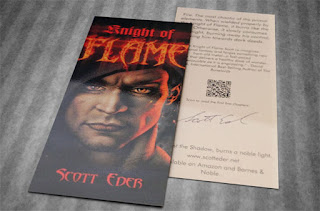I say see the front side as your opportunity to shine your light on the back. Here are two examples that show what I'm getting at.
The wrong way:
If you Google, you'll see that there's nothing distinctive about this: there are scads of links to this same I'll shoot you style of card. And you don't really need to see the back to know that this common cop-out shock effect represents unoriginal work, lacking depth and confidence. Deleting the Don'rt worry line does nothing to improve it: clearly, what the photographer wants isn't to shock us but to get a hug.
The right ways:
1) The design suggests the artist's style or spirit.
This is distinctive, tasteful and classy. And if it represents the designer's work, then I know what I'm getting--and I already want it. I'm eager to turn the card over for further contact information or key selling points.
2) The front design is seriously clever.
We may in the past have been put off Yoga because we think of it as painful or boring. Yet we know it could be good for us. This card is far beyond cute in the 'I'll shoot you' way. This is seriously clever because it suggests that this place would be fun. Yoga made less painful and more the masses. I want to see their contact information so I can give them a call.
3) The front design gives us a sample.
This card takes us in a useful direction for writers. I scrolled hundreds of author business cards, most wasting precious space by listing the name as both 'author' and 'writer', with phone and other contact information, maybe a boilerplate image of a typewriter as well. Here the author has given the front side to his book cover, sure to appeal to fantasy readers. Another author might choose to show his cover and a very brief quote from the book. Still another might actually offer a short sample of his prose. In all cases, the back side is reserved for contact and author information, After you've captured our interest, that's stuff we might like to know. Only then.
We'll cover the back side next week. For now, in summary:
1) Two-sided cards are most useful for those who aren't quite There yet.
2) If we aren't There, then our names and phone numbers don't mean a thing to anyone.
3) Avoid the cutesies at all cost and offer compelling instead.
4) Your card not about you, its's for us--and what can you offer that others cannot.
5) The front of the card exists to compel us to turn the card over,
6) The back of the card exists to convince us that you are the bomb.
7) The two sides add up to one--as in you're the one for me.















